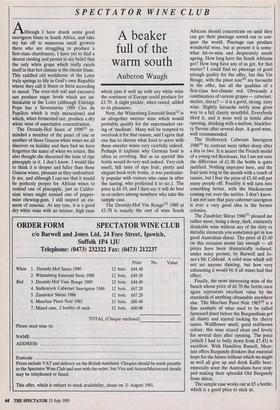SPECTATOR WINE CLUB
A beaker full of the warm south
Auberon Waugh
Although I have drunk some good sauvignon blanc in South Africa, and take my hat off to numerous small growers there who are struggling to produce a first-class chardonnay, I have yet to find a decent riesling and persist in my belief that the only white grape which really excels itself in that hot climate is the chenin blanc. This raddled old workhorse of the Loire truly springs to life in God's own Republic where they call it Steen or Stein according to mood. The over-rich soil and excessive sun produce sugar levels which are un- thinkable in the Loire (although Eldridge Pope has a Savennieres 1989 Clos du Papillon which is truly miraculous) and which, when fermented out, produce a dry white wine of superlative concentration. The Drostdy-Hof Steen of 1990(1) re- minded a member of the panel of one or another of those Gascon white wines we all discover on holiday and then find we have forgotten the name of when we return. She also thought she discerned the taste of ripe pineapple in it. I don't know. I would like to think it is deeper and fuller than those Gascon wines, pleasant as they undoubted- ly are, and although I can see that it would be perfectly proper for African wines to remind one of pineapple, just as Califor- nian wines might remind one of pepper- mint chewing-gum, I still suspect an ele- ment of osmosis, At any rate, it is a good dry white wine with an intense, high taste which puts it well up with any white wine the continent of Europe could produce for £3.70. A slight prickle, when tasted, added to its pleasures. Next, the Witzenberg Emerald Stein(2) is an altogether sweeter wine which would probably qualify for the supermarket rat- ing of 'medium'. Many will be tempted to overlook it for that reason, and I agree that one has to choose what food to serve with these sweeter wines very carefully indeed. Perhaps it explains why German food is often so revolting. But as an aperitif this bottle would do very well indeed. Very rich smell, full taste of ripe fruit, pretty and elegant hock-style bottle, it was particular- ly popular with visitors who came in after the tasting, who preferred it to no.1. The price is £4.10, and I dare say it will do best in re-orders among members who take the sample case. The Drostdy-Hof Vin Rouge(3) 1989 at £3.70 is exactly the sort of wine South Africans should concentrate on until they can get their pinotage sorted out to con- quer the world. Pinotage can produce wonderful wine, but at present it is some- what hit-or-miss and desperately needs ageing. How long have the South Africans got? How long have any of us got, for that matter? I could find no pinotage of good enough quality for the offer, but this Vin Rouge, with the pinot noir(6) my favourite in the offer, has all the qualities of a first-class hot-climate red. Obviously a combination of various grapes — cabernet, merlot, shiraz? — it is a good, strong, tasty wine. Slightly farouche nettly nose gives way to a full clarety mouthful. Everybody liked it, and it wore well in bottle after opening, drinking with a mellow, blackber- ry flavour after several days. A good wine, well recommended.
The Stellenryck Cabernet Sauvignon 1986(4) by contrast went rather sharp after a day or two. It is nearer the French model of a young red Bordeaux, but I am not sure the difference of £1.90 the bottle is quite justified. Nothing improper here, and the fruit lasts long in the mouth with a touch of tannin, but I fear the price of £5.60 will put many people off. Possibly it will turn into something better, with the blackcurrant coming out over the nettles. I don't know.
I am not sure that pure cabernet sauvignon is ever a very good idea in the former colonies.
The Zandvliet Shiraz 1986(5) pleased me rather more, being a deep, dark, eminently drinkable wine without any of the dirty or metallic elements you sometimes get in less good Australian shiraz. The price of £5,60 on this occasion seems fair enough — all prices have been dramatically reduced, under noisy protest, by Barwell and Jo- nes's Mr Cobbold. A solid wine which will not set anyone dancing, but how very exhausting it would be if all wines had that effect.
Finally, the most interesting wine of the bunch whose price of £6.70 the bottle once again represents excellent value by the standards of anything obtainable anywhere else. The Meerlust Pinot Noir 1985(6) is a fine example of what used to be called farmyard pinot before the Burgundians got all dainty and started looking for cherry tastes. Wallflower smell, good red/brown colour, this wine stayed clean and lovely for several days after opening. The price (which I had to bully down from £7.45) is excellent. With Hamilton Russell, Meer- lust offers Burgundy drinkers that essential hope for the future without which we might as well all give up and drink Kaffir beer, especially since the Australians have stop- ped making their splendid Old Burgundy from shiraz.
The sample case works out at £5 a bottle, which is a good price to stick at.


















































 Previous page
Previous page